CAE Exam Introduction
The CAE exam is also known as the C1 Advanced exam. It was called the Cambridge English: Advanced exam in the past but this has now changed.
'C1 Advanced' is a name that represents the level of the exam. If you pass the CAE exam, you have a C1 level of English. C1 is an advanced level of English and I will explain this in a lot more detail under the 'How to complete the CAE exam FAST' section of this page. Be mindful that many resources you find, will still refer to the C1 Advanced as CAE.
This page is full of really useful information including:
- tips and tricks for how to prepare for the exam quickly
- a spreadsheet for you to download and record your scores
- how to calculate when you're ready to take the exam
but there are 3 main parts of the page:
1. General Information about the CAE Exam
Where Can You Take The CAE Exam?
Which Institutions Recognise The CAE Exam?
2. CAE Exam Format
3. How To Pass The CAE Exam FAST!
Calculate your total scores for each exam section
Find out how many more marks you need to pass
Understand where you can gain the most marks in the quickest time
Why Take The CAE Exam?
The C1 Advanced exam is a globally recognised English language certification.
There are many reasons why you might want to take the CAE exam, including:
- getting into an English speaking university
- getting a better job
- getting visas
- wanting proof of your language ability.
Some of my students who have passed this exam, left me reviews saying how it has helped them in life. You can check out what my students have said here.
If you're convinced this is the exam for you, then you have come to the right place. On this website I will show you how to prepare yourself in the best way possible for the exam, while at the same time, saving yourself time and money by using the best resources with the right strategies. I want to stop you from spending too much time and money preparing with bad teachers or bad resources.
Where Can You Take The CAE Exam?
You can take the CAE exam in many countries around the world. You can find specific exam centres where you can take the C1 Advanced in different countries here or watch this video below and I will show you...
Which Institutions Recognise The CAE Exam?
As we saw above, the CAE: C1 Advanced can be taken in loads of different countries around the world. You can see a list of institutions and work places which recognise the CAE as a formal language qualification here. I also explain this in the video below...
I know that the certificate is now accepted by all universities in the U.K. as proof of entry.
Who Can Take The CAE Exam?
Watch the video below for some exam FAQs, including who can take the exam:
There are lots of different English exams and I compare a few of these on this page. But for now, let's look at the format of the CAE exam.
CAE Exam Format
There are 4 exam papers in the C1 Advanced (CAE) exam: Reading and Use of English, Speaking, Listening and Writing. I have designed my website to include lots of tips and techniques, strategy preparation and practice to help you prepare yourself for the exam and save lots of £$ money on private lessons and language schools.
i. Listening
40 minutes.
4 parts.
Part 1 – 6 questions - 6 marks
Part 2 – 8 questions - 8 marks
Part 3 – 6 questions - 6 marks
Part 4 – 10 questions - 10 marks
The Listening section has 4 parts including multiple choice and sentence completion questions. You listen to conversations set in different contexts. In order to prepare for this, you need to be able to locate and select both general and specific information.
For more free tips and techniques to pass this section of the exam:
1. Check out my quick revision CAE Listening page >>
or
2. Start my longer CAE Listening course >>
ii. Reading & Use Of English
90 minutes.
8 parts.
The Reading and Use of English paper consists of 8 parts and this paper lasts 1 hour and 30 minutes.
Parts 2-4 – Use of English
Part 2 – 8 questions - 8 marks
Part 3 – 8 questions - 8 marks
Part 4 – 6 questions - 12 marks
Parts 2, 3 and 4 form the 'Use of English' section and focus on grammar and vocabulary.
Parts 1, 5, 6, 7 and 8 – Reading
Part 1 – 8 questions - 8 marks
Part 5 – 6 questions - 12 marks
Part 6 – 4 questions - 8 marks
Part 7 – 6 questions - 12 marks
Part 8 – 10 questions - 10 marks
Parts 1, 5, 6, 7 and 8 form the 'Reading' section. Part 1 tests your knowledge of word families and sentence structures. Parts 5-8 test your overall comprehension and awareness of how sentences and paragraphs fit within different written texts. They also test your ability to find and understand small differences in meaning between similar looking sentences.
If you want to learn more about the Reading and Use of English paper, you have 4 options:
1: Use of English - quick revision page >>
2. Reading - quick revision page >>
These quick revision pages teach you the techniques to pass this exam paper and show you where you can practise these techniques. These pages form part of my short CAE course which is better for you if you don't have long to prepare for the exam.
My longer Reading and Use of English courses form part of my BIG CAE course, which takes you through all the papers in this exam. The individual courses inside, show you the best techniques to use and let you practise these with various exercises. They also test your understanding of varying word types, sentence structures and collocations. These are all important areas to practise when preparing for the CAE.
iii. Speaking
15 minutes.
4 parts.
The Speaking section has 4 parts. The first part is a general chat between the candidate and the examiner when they typically ask personal questions. In part 2, you have one minute to answer a question about some different pictures. You then answer a question about another candidate's pictures. In part 3 the examiner gives you a topic to discuss with another candidate for 2/3 minutes. You then have one minute with your partner to answer another question. In part 4, you have a further discussion which is connected to the topic in part 3.
If you want to learn more about the Speaking paper, you have 2 options:
1. Head over to my CAE speaking test tips and technique quick revision page - revise the format of the exam and learn some techniques for each part.
2. Start my C1 Advanced (CAE) speaking course. This takes you through each part of the speaking exam in detail. You can watch sample tests, complete practise exercises and more.
iv. Writing
The Writing section of the exam has 2 parts. The first part requires students to write a 220-260 word essay. You must write about 2 points from a choice of 3 and explain why one point is the most important. In the second part, you have to write a 220-260 word letter, proposal, report or review.
The writing parts are assessed on a scale of 1 (poor) - 5 (great) for: Content, Communicative Achievement, Organisation and Language. It's really important to understand these marking criteria to get good marks in the exam. Luckily, I explain these for you in more detail in my:
1. C1 Advanced writing - quick revision page >>
or
How To Pass The CAE Exam FAST!
Do you need to pass the CAE exam FAST? Maybe you are time restrained, maybe not, in any case, the following information WILL HELP YOU…
Aim of the game:
Average 61% + across all 5 exam sections and pass the C1 Advanced exam.
How to do it?
Follow this 4 step strategy:
Step 1 - Complete a Sample Test
Step 2 - Calculate your total scores for each exam section
Step 3 - Find out how many more marks you need to pass
Step 4 - Understand where you can gain the most marks in the quickest time
Side note: I do not recommend rushing to take the exam, but I know some of you will be in the situation where you are desperate to take the exam ASAP and so this article is especially for you...
If you are not in a rush to take the exam, the information here will still be very valuable for you as we cover some very important information about the exam in a lot of detail!
Step 1: Complete a sample test
Complete a Reading and Use of English and Listening exam paper on the Cambridge website: https://www.cambridgeenglish.org/exams-and-tests/advanced/preparation/
In order to assess your Speaking and Writing, you’ll need to ask a teacher, and VERY IMPORTANTLY, ask them to mark you based on the official examiner criteria (I talk more about these later).
If you want a reliable service, I offer Speaking and Writing assessment services on my website:
https://studentlanguages.com/cae-speaking-assessment/
https://studentlanguages.com/cae-writing-assessment/
Make sure you complete the sample exam paper under exam conditions, which means you should stick to the time limits. If you do a paper based sample, practise transferring your answers to a separate answer sheet within the time limit!
Step 2: Calculate your total scores for each exam section
How To Calculate Your CAE Exam Score
What is the Cambridge English Scale?
How many marks are available for the different exam sections?
How do my CAE exam marks translate to the Cambridge English Scale (CEFR)?
Averaging your section scores to find your overall CAE exam score
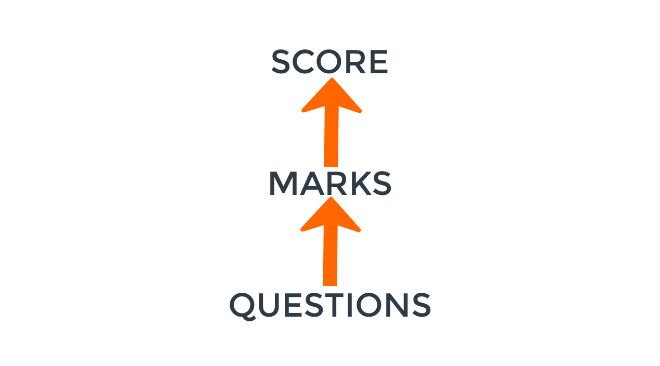
How To Calculate Your CAE Exam Score
Well, Cambridge English made calculating your CAE exam score very confusing, thanks Cambridge English! But, don’t worry, I’ve spent a long time working it all out and making it easy for you. If you read the information below in full (not skipping parts) you’ll really understand it and that will help us a lot when it comes to step 3 (fast tracking our way to exam success).
There are 5 sections in the CAE exam, which are all marked separately: Listening, Reading, Use of English, Speaking and Writing.
*Note, Reading and Use of English are marked separately, despite being combined into 1 exam paper.
You need to calculate your scores for each of the 5 exam sections, but this is not straightforward, so you’ll need my help with these calculations...we will cover this in a minute!
Remember, you’ll also need the help of a teacher/examiner to assess your Speaking and Writing.
Right, let’s learn more about how you and examiners/teachers calculate your scores. The first thing we need to do is understand the Cambridge English scale.
Why?
Because this is how examiners decide whether you pass or fail the exam, so...
What is the Cambridge English scale?
The Cambridge English scale is the same as the CEFR (Common European Framework of Reference for Languages). This is a scale which measures your language level on a scale of 80-230.
80 is A1 (low level) and 230 is C2 (proficient level).
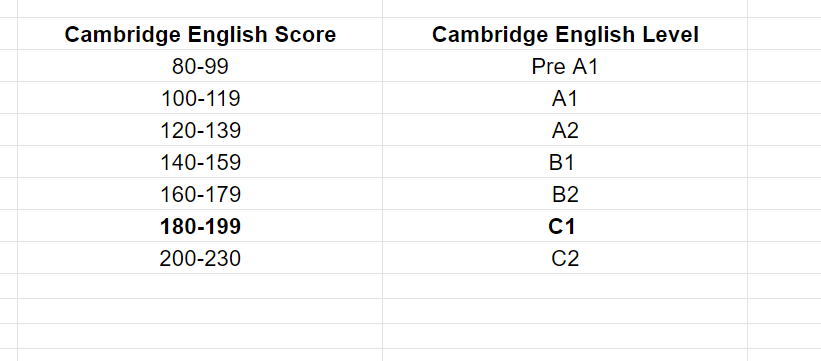
As you can see in the picture above, you need to get a score of 180 or higher to achieve a C1 level and pass the CAE (hence its name C1 Advanced).
Luckily each of the 5 exam sections are individually measured using this scale. This means it’s easy to calculate your total score by averaging the scores from the 5 sections.
The score you get for each exam section depends on how many marks you get correct for each section.
Okay, did you follow that so far?
Great!
Unfortunately, things are about to get a little more complicated...

But I will try to explain in a simple way...
Even though the number of marks you get determines your Cambridge English score, the number of marks available is different for each section of the exam.
For example, you can get a maximum of 30 marks in the Listening paper, but a maximum of 40 marks in the Writing paper...
How many marks are available for the different exam sections?
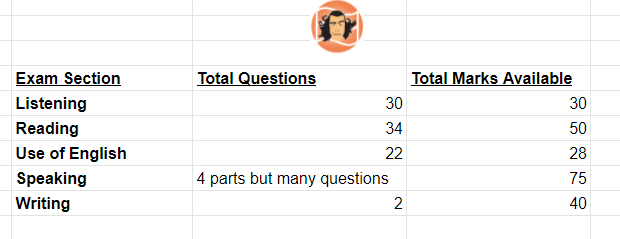
As you can see in the picture above, there are different numbers of questions in each exam section and each question does not always receive 1 mark.
Some questions are awarded 1 mark whereas other questions are awarded 2 marks.
So, let's break this down to make it simpler...
Listening: 30 marks available (30 questions)
Reading: 50 marks available (34 questions)
Use of English: 28 marks available (22 questions)
Speaking: 75 marks available (There are 4 parts but there can be many questions in Parts 1 and 4. Your answers are based on 6 marking criteria which we will look at later).
Writing: 40 marks available (You should only answer 2 questions and your answers will be marked on 4 marking criteria).
Okay, there's one important question which we still haven't answered...
How many questions do I need to answer correctly to get enough marks to get a high enough score to pass the CAE exam?
Once again, thanks Cambridge English for making this so simple 🙂
So...
Translating my marks to the Cambridge English Scale (CEFR)?
At this point, it’s easier to analyse the 5 exam sections separately in order to understand how the marks above translate to the Cambridge English scale.
You can then calculate how many questions you need to answer correctly in order to pass each section of the exam.
*Remember, you actually don't need to pass each section of the exam...but you do need your average mark across the 5 sections to be above 180. I explain this in more detail later 🙂
Listening

26-30 out of 30 available marks = 200-230 on the Cambridge English scale = C2 level
18-26 out of 30 available marks = 180-199 = C1
13-17 out of 30 available marks = 160-179 = B2
11-12 out of 30 available marks = 142-159 = B1
Any score lower than 11 (142) is not reported.
Remember, you get 1 mark per question for the Listening section.
18 out of 30 is 180 which is C1 level. This means you need a minimum of 18 correct answers from 30 questions in order to pass the Listening paper. 18 out of 30 means you need to answer 60% of the questions correctly.
Here is how your correct questions translate to marks and scores:
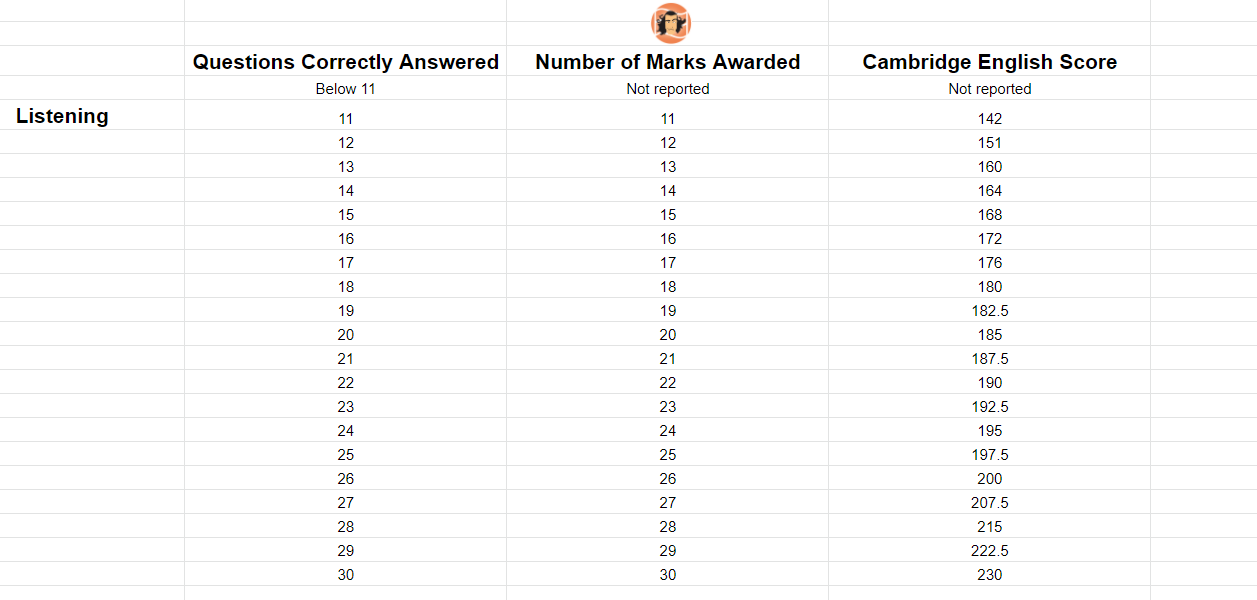
Reading

43-50 out of 50 available marks = 200-230 = C2
32-42 out of 50 available marks = 180-199 = C1
23-31 out of 50 available marks = 160-179 = B2
17-22 out of 50 available marks = 142-159 = B1
Any score lower than 17 (142) is not reported.
So, we need a minimum of 32 out of 50 available marks to get 180 or C1 level and pass the Reading section.
32 / 50 is the equivalent of 64% - BUT...and this is IMPORTANT...
because some parts of the Reading section are awarded double points, there is a way to get 32 marks by only answering 47% of the questions correctly, dun dun dun…
”How to game the system by Cambridgerory” 😉
We will come back to this later when discussing Step 4 - Understand where you can gain the most marks in the quickest time.
This is as close as I’ve come to guessing how your specific marks translate to scores in the Reading section...
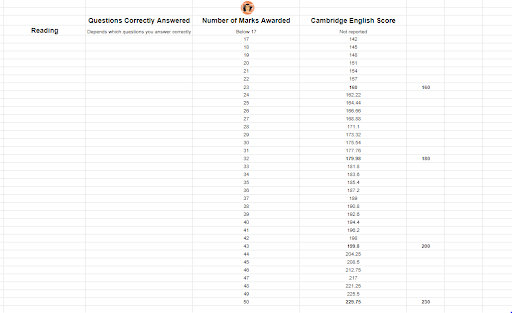
I know the picture above is a bit blurred. You can actually see all these scores more clearly on this document >>
Make sure you go to the relevant sheet at the bottom (see the next picture):
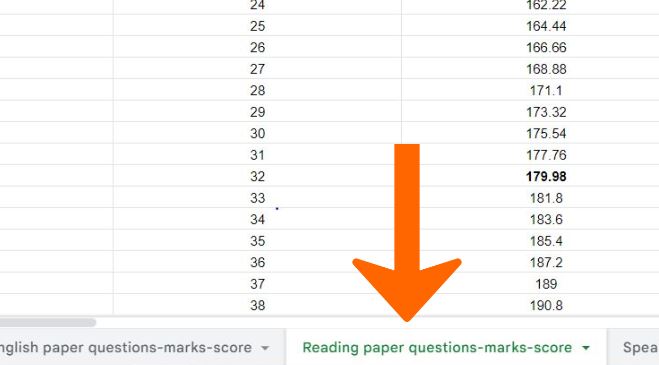
Use of English

23-28 out of 28 available marks = 200-230 = C2
16-22 out of 28 available marks = 180-199 = C1
11-15 out of 28 available marks = 160-179 = B2
8-10 out of 28 available marks = 142-159 = B1
Any score lower than 8 (142) is not reported.
16 is the minimum number of marks you need to achieve a C1 level in the Use of English section. That is 16 out of a possible 28 which is 57%. However, there are 22 questions in this section and part 4 is double marked, so there is a way to get 16 marks by answering 10 questions correctly. 10 questions out of 22 is 46% of the questions...dun dun dun
“How to game the system by Cambridgerory chapter 2” 😉
Again, we will come back to this later 😉
This is my guess as to how your specific marks translate to scores in the Use of English section:

Speaking

66-75 out of 75 available marks = 200-230 = C2
45-65 / 75 = 180-199 = C1
30-44 / 75 = 160-179 = B2
17-29 / 75 = 142-159 = B1
Any score lower than 17 (142) is not reported.
So, you need to get 45 marks out of a possible 75 in order to pass the C1 Advanced Speaking paper.
But how do you get marks?
These are based on 6 marking criteria.
The examiners give a grade from 0-5 for the first 5 marking criteria below. These grades are then multiple by 2 to calculate the marks.
So, you can get a maximum of 10 marks for each or 50 marks in total.
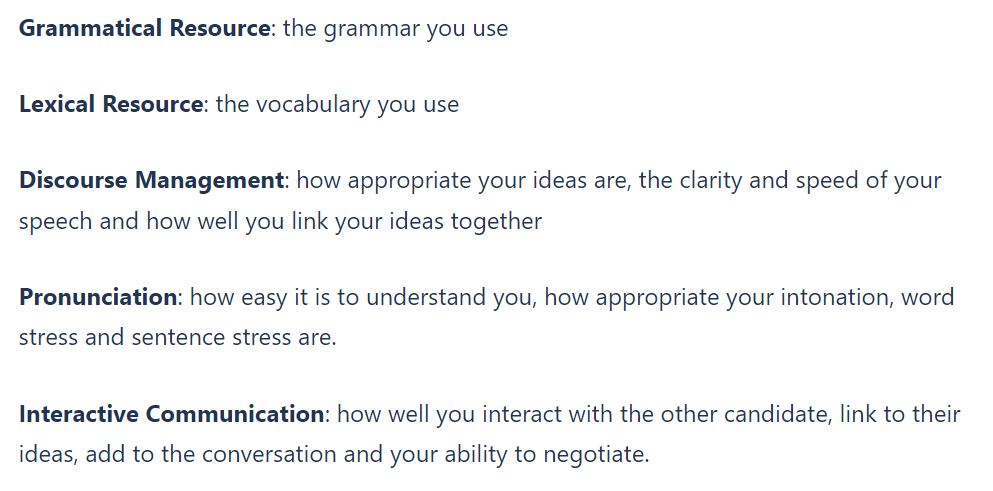
The final criterion 'Global Achievement' below is also graded from 0-5 but this is then multiplied by 5 to calculate the mark. So this criterion has a maximum of 25 marks in total.
50 + 25 = 75.

There are some simple tricks you can and should use in the Speaking paper to get higher marks for these criteria. Again, we will look at these in more detail shortly.
Below is a chart showing how close I’ve come to calculating individual Speaking scores on the Cambridge English scale:
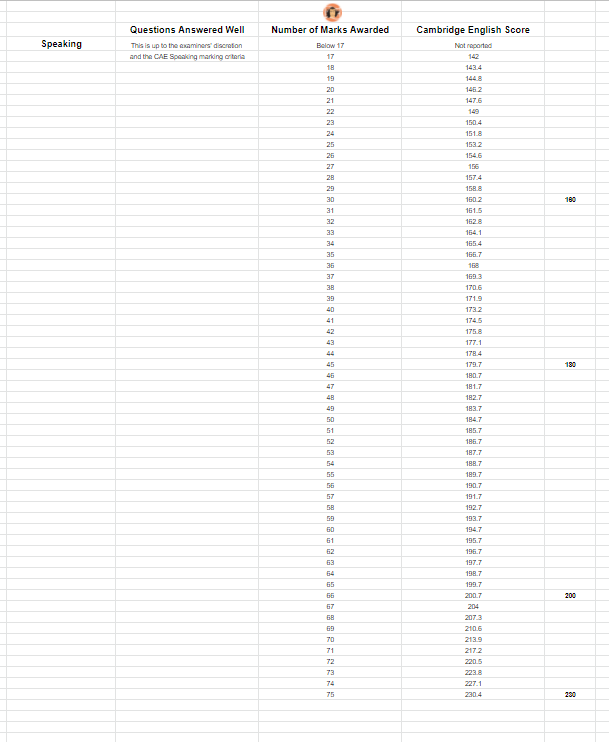
Writing

34-40 out of 40 available marks = 200-230 = C2
24-33 / 40 = 180-199 = C1
16-23 / 40 = 160-179 = B2
10-15 / 40 = 142-159 = B1
Any score lower than 10 (142) is not reported.
So, you need to get 24 marks out of 40 in order to pass the C1 Advanced Writing paper.
The marks are awarded on 4 criteria. These 4 criteria are each marked on a scale of 0-5.
So, you could get 20 marks, but remember, there are 2 questions to answer = 40 marks available in total.

There are some ways to prepare in a quick time but get higher marks for these criteria and I will mention those in the next section.
The following table shows the scores I think you get for each mark in the Writing paper:
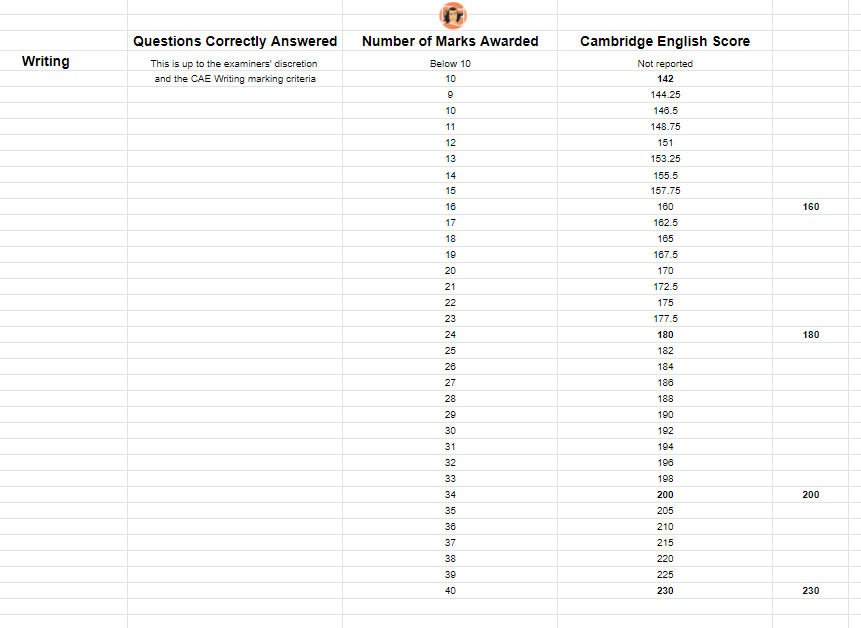
So, if you get 3 for each criterion for the first question, you receive 12 marks.
If you receive 3 for each criterion for the second question, you receive another 12 marks.
You would get 24 marks in total = 180 (C1 level).
Remember, you do not need to pass every paper in order to get a C1 Advanced certificate, but you do need to have a total average score of 180 + from the 5 different exam sections combined.
Averaging your scores to find your overall CAE exam score
This is the easy part.
For each exam section, write down your Cambridge English scale score based on the number of marks you were awarded, add them together and divide this number by 5.
I have created a spreadsheet to do this calculation for you:
- Download this document to your computer
- Write the number of marks you get on row: 22, columns: C, H, M, S, Z
- Follow the instructions in row: 28, column C
- See your total exam score in row: 33, column H
- See how many more points you need to score to pass the exam in row 38, column H - remember these are the points you need and the number of marks you need to get those points differs depending on the exam section.
*I have created another sheet in the document which allows you to input 10 different exercises and consequently calculates the same information. You can see the sheet in the picture below:
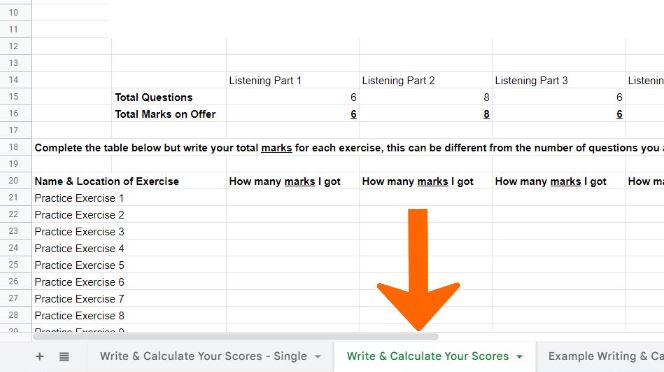
There is an example students marks with information and explanations in another sheet in the document:

Step 3: Find out how many more marks you need to pass
If you've followed the steps above and filled in the information on the spreadsheet, then you should easily be able to calculate how many more marks you need to pass.
If you've only completed 1 exercise, you can see this on row 38, column H of the first sheet in the spreadsheet.
If you've completed and inputted your scores for 10 practice examples, you can see this on row 49, column H of the second sheet.
If you've completed somewhere between 1 and 10 or more than 10 practice examples, all you need to do is tweak the formula in row 32 to average the sum by the number of tests you did. For example, if I do 5 tests, the sum in row 32, column C should be: =SUM(C21:C25)/5.
Example
Guess what? Rather than giving your average score, the ‘How Many More Points Do I Need To Pass The C1 Advanced: CAE Exam?’ box will now show you the number of points you need to improve by in order to pass the exam. Amazing, I know. If it shows a minus figure, you've either put the data in incorrectly or you're already good enough to pass the exam!
So the person in the picture above will need to improve their score by 36 points.
This doesn’t necessarily mean they have to answer 36 more questions correctly however, because some questions can equal 2 marks....and the number of marks don't always equate to the number of points...it changes depending on the exam section 😉
So how many more marks do we need to achieve the required points?
This can vary on a number of factors, but this is what I would do:
- Look at my weakest area (in the example above it's Use of English with 148).
- Add this score to how many more points I need = 148 + 36 = 184.
- Go to the Use of English sheet at the bottom of the document and see how many more marks I need to get from 148 to 184...
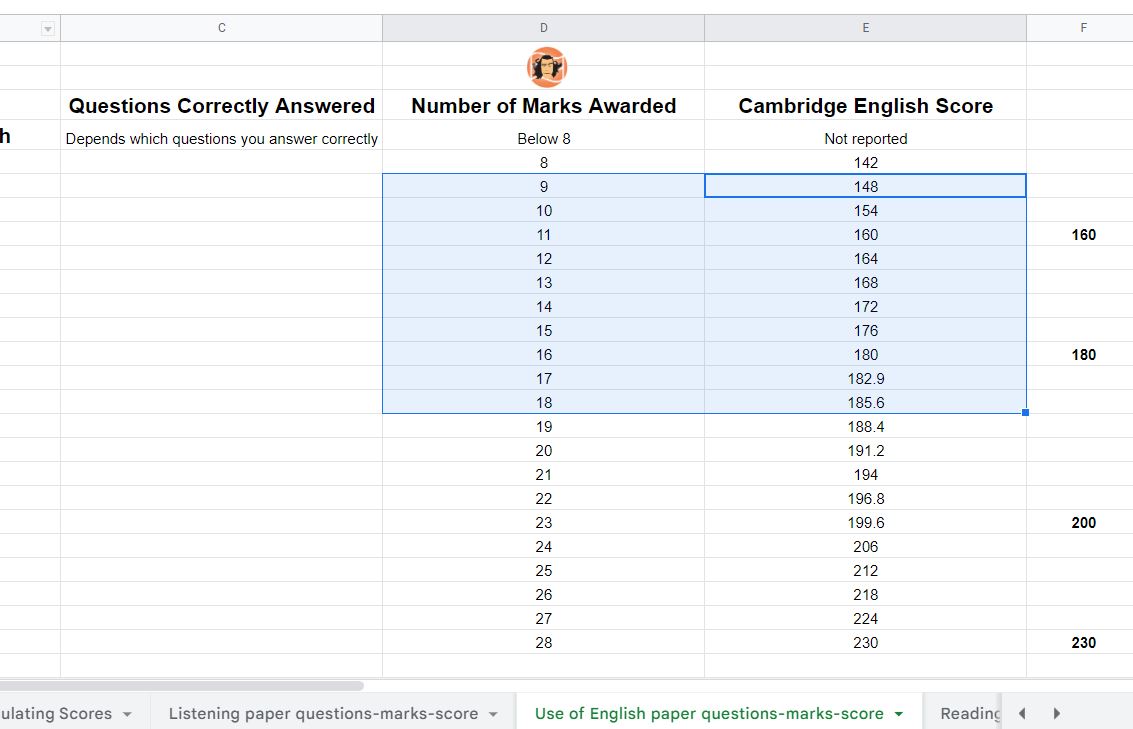
So, for my example above we are currently on 9 marks in the Use of English paper = 148 and we need 9 more marks (18 marks) to get above 184.
How many more questions do we need to answer correctly in the Use of English paper in order to achieve this 9 marks? This depends on which part of the Use of English paper we are answering.
Activity
Let's see if you've followed and understood the information above correctly.
Sorry, this activity is for higher-level members only. Become a higher-level member today >>
BEWARE many students tell me the actual exam is more difficult than the practice tests they complete beforehand. For this reason, I advise my students to average 70% (185-190) or higher before booking their exam. I also advise trying to achieve 180 + in all 5 sections of the exam, but remember, you don’t need to pass all the different parts in order to get the C1 Advanced certificate, it is your average score across all 5 sections which counts.
“But Rory, I’m taking my exam really soon, how can I improve my scores by that much in a short space of time!?”
This is a good question so let’s look at a few tactics you can use...
Step 4: Understand where you can gain the most marks in the quickest time
If you’re in a rush to take the exam, this is the tactic I recommend. It might not work for everybody, but it’s definitely worth trying...
- Format.
Learn the whole exam format inside out and save yourself crucial time.
- Rank.
Use steps 1 and 2 above to rank your strongest to weakest areas.
For example:
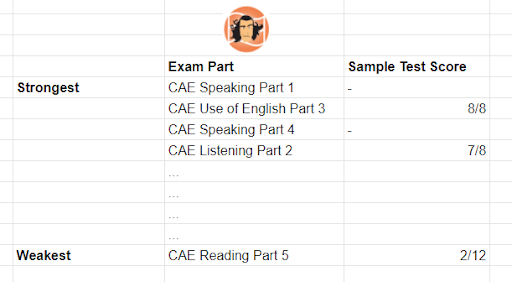
- 2 / 3.
Learns some techniques and tips to use for your 2 / 3 weakest parts and 2 / 3 strongest parts.
When doing this, you should start on the parts which are worth 2 marks per question! You can find how many marks you are awarded per question here.
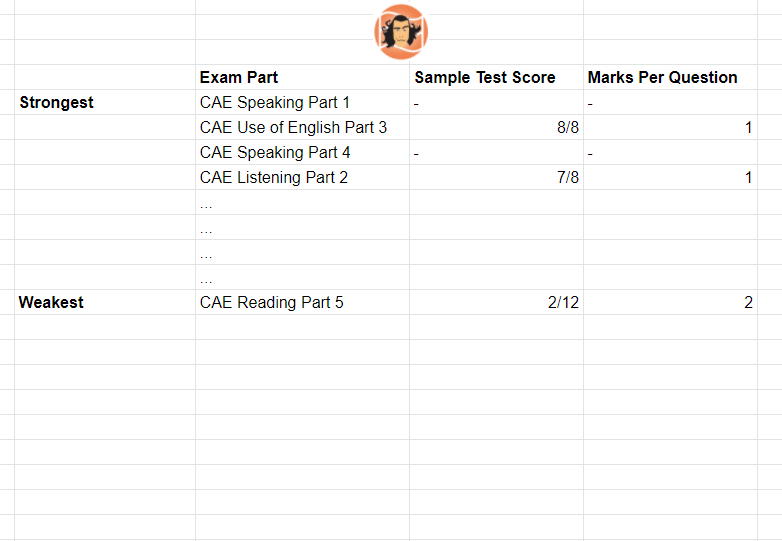
So, let’s say you want to improve your 3 worst and 3 best areas by a total of 36 marks (as in the example below:

Your 3 worst areas are:
CAE Use of English Part 2
CAE Use of English Part 4
CAE Listening Part 4
And your 3 best areas are:
CAE Speaking Part 1
CAE Writing Part 1 - Essay
CAE Reading Part 8
You’ll need an average of 6 more marks in each of these parts in order to pass the exam.
However, it’s unlikely you’d be able to improve your best areas by 6 marks each, so let’s say you improve your 3 worst areas by 8 marks each and your 3 best areas by 4 marks each.
CAE Use of English part 4 is worth 2 marks per question, so I’d advise focussing on this part first as you’d only need to get the equivalent of 4 more questions correct in order to make up those 8 marks.
Why Should I Focus on the Parts Worth 2 marks first?
Simple, you can answer fewer questions correctly but still gain enough marks to pass. You can only employ this tactic for the Reading and Use of English sections however, so we’ll have a look at these first, then we’ll learn some quick ways to boost our exam score for the other sections.
Reading Example:
We established that you need 32 marks from 50 to pass the Reading section at C1.
32 / 50 = 64%
But we also mentioned that getting 64% of the questions correct doesn’t necessarily mean you get 64% of the marks and this information can be very valuable to us.
What do I mean? Well....
What is 64% of 34 (questions)? The answer is 21.76 questions, but let’s say 22 questions.
22 questions is 64.7% of the total number of questions. However, because some questions are awarded 2 marks and some are only awarded 1 mark, answering 22 of the questions correctly doesn’t necessarily mean you get 64% of the marks and thus might not be enough to pass the Reading section.
However, Parts 1 and 8 are awarded 1 mark per question, whereas parts 5, 6 and 7 are awarded 2 marks per question.
So, let’s look at an example…
Maria does the Reading section:
For parts 1 and 8, there are 18 questions and 18 marks available. Maria answers all of them correctly, YIPEEE!!
If she then only answers 4 other Reading questions correctly, she will have answered 22 questions correctly out of the 34 questions. That’s 64% of the total questions she has answered correctly...FANTASTIC….but wait...
in part 5 the questions are double weighted remember, which means she has scored 8 marks for those 4 correct questions.
If we add those 8 marks to the 18 marks she got for Parts 1 and 8, she has scored 26 marks from 50 = 52%, but she needs 32 marks out of 50 (64%) to pass….UH OH 🙁
So Maria answered 64% of the questions correctly, but she only received 52% of the total marks and she did not pass the Reading section at a C1 level.
Oh dear.
BUT, there is a flip side to this, it is possible to answer 47% of the question correctly and pass with a C1 grade.
Do you remember that there are 34 questions in total?
Do you remember that parts 5, 6 and 7 are worth 2 marks each?
Parts 5, 6 and 7 have a combined total of 16 questions but they offer 32 marks.
If you answer all these 16 questions (parts 5, 6 and 7) correctly, you will get 32 marks out of 50 and you will pass the Reading paper with a C1 level by only answering 16 of 34 questions (47%) correctly.
To be clear, I do not recommend using this as your exam strategy! However, it might help you when deciding where to focus your attention if you only have a very short time to prepare for the exam.
Use of English Example:
We know now that you need a minimum of 16 marks from a total of 28 possible marks to pass the Use of English section at C1 level.
We know that 16 / 28 = 57.1%
However, we also know that getting 57% (13 questions) correct doesn’t automatically mean you’ll get 16 marks or 57.1% of the marks available. Again, this is because part 4 is double weighted meaning you get 2 marks for every correct question. If you are terrible at part 4 Key Word Transformations, it may offer you some comfort to know that you can get a C1 level in Use of English by answering every question in parts 2 and 3 correct = 16 questions and 16 marks. However, it’s really difficult to get all those 16 questions correct and so it would be silly to bank on that as your exam paper tactic.
Rather, if you don’t find Key Word Transformations absolutely bloomin’ impossible, then you have the opportunity to use this part to your advantage and cash in on those double marks.
If you answer all 6 part 4 questions perfectly, you’ll only need to answer 4 more out of the remaining 16 questions correctly in order to get enough marks to pass the Use of English paper.
Now, again, I repeat, I do not recommend putting all your attention on part 4 as your Use of English exam strategy, but this knowledge can help you decide where to focus if you don’t have much preparation time.
How can you improve those 4/6 areas by so many marks in such a short space of time?
Learn the best techniques for these parts!
You can do this while at the same time practising exam exercises by joining my CAE Crash Course >>
I then advise doing several more exercises on these parts until you are confident that you have improved your scores in these areas.
- Measure.
Measure your progress and your overall score by doing another sample test. If you’re still not achieving a score of 180 (61% +), practise more on the areas you previously identified that you are still finding particularly difficult.
Still struggling to get the grade?
- Study Smart.
Whether you have lots of time to prepare or not, I would always advise studying smart...and this is the basis for most of the work I produce!
What do I mean by ‘study smart’?
If your exam is very soon and you have followed the steps above, focussing on your strongest and weakest areas, but you are still struggling to get a good enough grade in your practice tests, you might need to try and solve the other parts of the exam in a smarter way!
I advise saving some time by learning the techniques while simultaneously practising exam exercises for all the other parts of the exam, through my:
However, if you have more time, you could also:
Read the techniques in my ‘C1 or not C1?’ ebook >>
Practise the techniques further in my full CAE Course >>
Learning and practising #cambridgerory exam techniques is a really efficient way to QUICKLY improve your score, especially as they are based around examiner marking criteria and ticking examiners’ boxes.
For the Speaking paper, I recommend not only following the techniques from my courses, but also having a read of this really useful pdf document which talks about the marking criteria in more detail. It also shows you what examiners expect to hear in order to get ‘5’ or top marks in the Speaking paper. There are also some exercises which will be really useful to complete: https://www.cambridgeenglish.org/images/168620-assessing-speaking-performance-at-level-c1.pdf
For the Writing paper, the best way to prepare in a fast time is to understand the marking criteria inside out. I gave a quick overview of these above, but I have a more detailed CAE Writing Marking Criteria page to further help you with this. You should then read other students writings with my feedback (you can do this with my ‘CAE Writing Samples’ book). Make a note of all the positive points I made for each writing. Reading this book will give you a good idea how to tick the examiners boxes for the criteria above. I’ve also made a couple of videos examining some CAE Writing samples.
Final Ways To Quickly Boost Your Exam Score
Finally, here are 10 quick tips to increase your chances of success in the exam:
- Write an answer to every question.
- Skip to the parts which you can complete fastest.
- Know how the examiners mark your Speaking and Writing papers.
- Revise recommended collocations and phrasal verbs before the exam.
- Revise word families and sentence structures before the exam.
- In Listening part 1, cover the options and just focus on the question.
- In Use of English part 2, watch out for short words.
- In Reading part 7, watch out for determiners and pronouns.
- In Speaking part 2, compare and contrast the pictures.
- In Speaking parts 3 and 4, use ‘OWA’.
If you are confused by any of those 10 tips, have a look around my website or in my ‘C1 or not C1?’ book and you will find the answers!
Paper based exam tip: Remember to save 5 minutes at the end of each section to move your answers to the answer sheet.
Conclusion
Remember, you need a score of 180 in order to pass the C1 Advanced exam. 180 / 230 is not 60%, it is 78% but don’t worry...the way the marks translate from your answers to the Cambridge English scale is complicated (see above) and you actually only need to average 60.54% across all 5 exam sections in order to pass the exam:
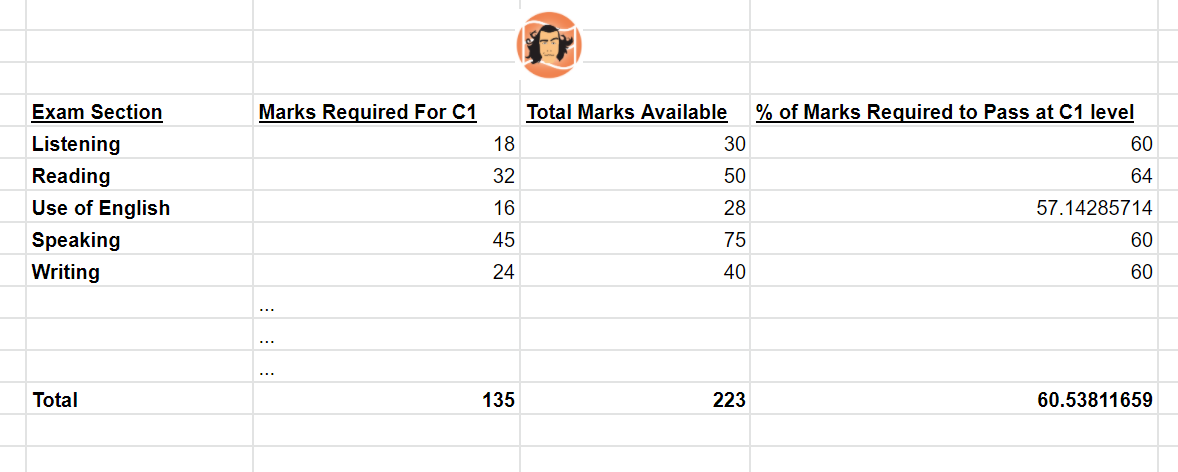
Also, even though you need to average 60.54% of the marks in order to pass the exam, you can pass the Reading section only answering 47% + of the questions correct and you can pass the Use of English section only answering 46% of the questions correct (depending on which questions you get correct).
The truth is, it will be very difficult to improve your exam score by LOADS of marks in such a short space of time and if you have a good amount of time, I would always advise following a more holistic approach, aiming to improve ALL the different parts of the exam. However, if you are short on time, I hope the tactics and solutions I offered above prove very useful for you. As a reminder:
- Format
- Rank
- 2 / 3
- Measure
- Study Smart
It took many years of experience and quite a long time to produce this page, so I hope you enjoyed it!
Continue with the short (20-hour) CAE course >>
Continue with the long (100-hour) CAE course >>
